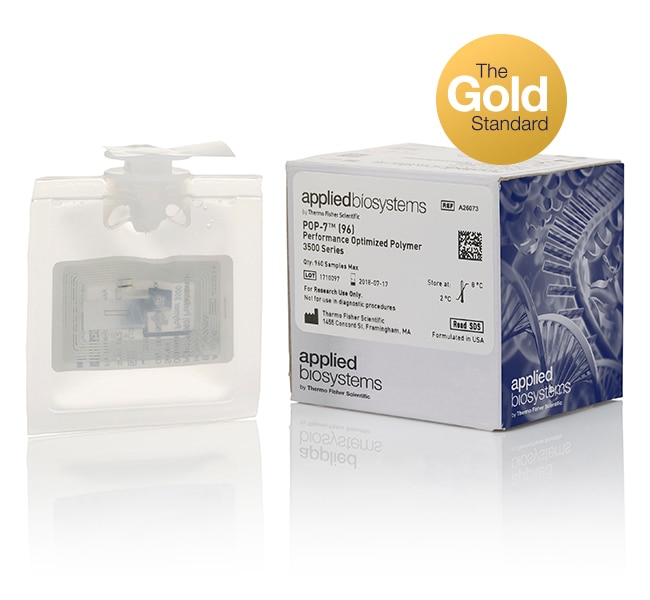Search Thermo Fisher Scientific

POP-7™ Polymer, for 3500/SeqStudio™ Flex
POP-4, POP-6, and POP-7 are conveniently offered in easy to use pouch packages with multiple sample size formats. The POP-7 separation matrix is optimized for short- to long-read sequencing and fragment analysis.
• Easy to use: pre-formulated and in a single use pouch, which not only saves time but also ensures reliability and consistency
• Include radio frequency identification (RFID) label: easy to track important information such as part⁄lot number, samples remaining, and expiry dates (displayed on software dashboard)
• Robust formulation: formulated for sequencing and fragment analysis applications
• Replenishable: allow capillaries to be used multiple times
Reproducible Results
POP polymers dynamically coat the capillary wall to control electro-osmotic flow. Their definite quality and uniform consistency eliminate guesswork and help to ensure reproducibility. POP Polymers are specifically formulated to separate DNA fragments of a known size range at a desired resolution and run time.
Many Choices
POP-7 polymers are very versatile and designed for a wide range of short read to long read sequencing applications as well as fragment analysis. POP-4 polymers are designed specifically for HID⁄Forensic applications, while POP-6 polymers are the choice for certain sequencing applications (and fragment analysis).
For partially used pouches that need to be stored, a cap (4412619) that plugs into the pouch fitment opening is recommended.
Customers who viewed this item also viewed
Documents & Downloads
Certificates
Safety Data Sheets
Scientific Resources
Product Information
Limited Use Label Licenses (LULL)
Notice to Purchaser: This product is optimized for use in the DNA sequencing or fragment analysis methods covered by patents owned and/or controlled by Life Technologies Corporation (“LTC”). LTC does not convey any right or license under these patents, whether expressly, by implication, by estoppels, or otherwise, to the purchaser by the purchase of this product to use the DNA sequencing or fragment analysis methods. Notwithstanding the foregoing, a limited license to use the DNA sequencing or fragment analysis methods covered by such patents can be obtained for certain research and development activities (a) through the purchase of certain LTC reagents when such reagents are used in conjunction with an authorized LTC instrument, or (b) directly from LTC. For information on obtaining additional rights to practice the DNA sequencing or fragment analysis methods, please contact outlicensing@thermofisher.com, Licensing and Commercial Supply, Thermo Fisher Scientific, 5823 Newton Drive, Carlsbad, CA, 92008, United States.
'Frequently asked questions (FAQs)
There is no difference between the compositions of POP-7 in POP-7 Polymer for Protein Quality Analysis (Cat. Nos. A30936, A31122) and POP-7 Polymer, for 3500/SeqStudio Flex (Cat. Nos. 4393708, A26703, 4393714) as they come from the same manufacturing bulk/formulation.
Find additional tips, troubleshooting help, and resources within our Protein Assays and Analysis Support Center.
When placing the array on the instrument, the last step in the process is to loosen the array knob and the instrument forces any air bubbles around the array tip through the threading and the middle of the array knob. Some polymer gets pushed through as well and when it dries up, it appears as a white, flaky residue. Use a damp, lint-free cloth to remove it.
Find additional tips, troubleshooting help, and resources within our Capillary Electrophoresis Instruments Support Center.
On the Applied Biosystems 3500 Series Genetic Analyzer, the polymer pouch may not be sitting properly or the check valve may be stuck in the open position. Carefully detach the polymer pouch by pulling down the handle next to it, and then pull the handle up while guiding the pouch into place and secure it by pushing up on the plastic head of the pouch. If this fails, perform a wash on the system using the conditioning pouch. If reseating the tube/pouch and cleanup do not fix the problem, a service call may be required.
Find additional tips, troubleshooting help, and resources within our Capillary Electrophoresis Instruments Support Center.
Some of the other causes of an Unstable Electrophoresis current detected error message are:
1.Leak on the system
2. Polymer that:
-Has expired
-Has been left on the instrument for more than the recommended time
-Is a mixture of expired polymer and non-expired polymer
3. Running Buffer that was:
-On the instrument longer than 2 weeks
-Not filled to the fill line or evaporated below the fill line
4. An arcing event that was not cleaned afterwards using the water wash wizard
5. Not performing regular maintenance on the instrument
6. Hardware issues
Inspect the system for leaks. If you do not see any leaks on the system, perform the wash the pump chamber and channels wizard using the conditioning pouch and place fresh, non-expired polymer and fresh Anode and Cathode buffer containers. If the problem persists, a service call may be required.
Find additional tips, troubleshooting help, and resources within our Capillary Electrophoresis Instruments Support Center.
If we do not specify the expiry date or number of uses, the warranty will last for 12 months from the date of shipment.
Find additional tips, troubleshooting help, and resources within our Capillary Electrophoresis Instruments Support Center.